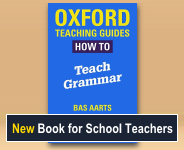Explanation
The auxiliary verbs are be, have and do and the modal verbs. They can be used to make questions and negative statements. In addition:
- be is used in the progressive and passive
- have is used in the perfect
- do is used to form questions and negative statements if no other auxiliary verb is present
- They are winning the match. [be used in the progressive]
- Have you finished your picture? [have used to make a question, and the perfect]
- No, I don't know him. [do used to make a negative; no other auxiliary is present]
- Will you come with me or not? [modal verb will used to make a question about the other person's willingness]
Auxiliary verbs 'help' the main verb they precede by adding further shades of meaning such as aspect or modality. E.g. They are leaving; She has finished; We should help him.
Englicious contains many resources for English language in schools, but the vast majority of them require you to register and log in first. For more information, see What is Englicious?

